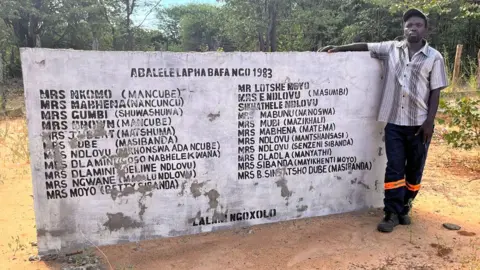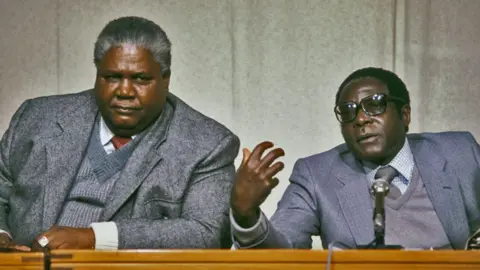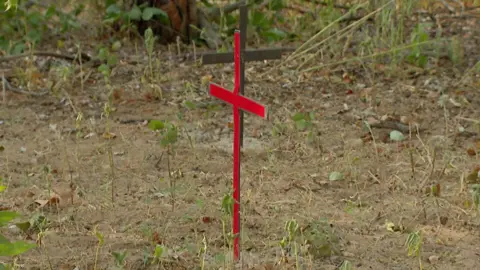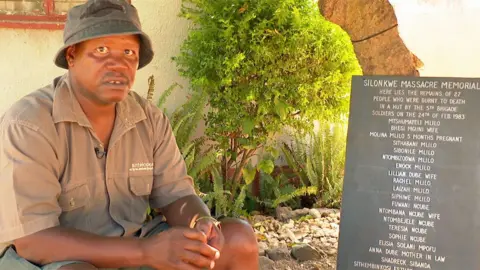[ad_1]
By Shingai Nyoka, BBC News, Tsholotsho
 BBC
BBCAn astounding number of mass graves surround Thabani Dhlamini’s home in south-western Zimbabwe.
One pointed out to the BBC lies near the ablution block at a primary school in the village of Salankomo in Tsholotsho district. Teachers were killed and dumped there in the 1980s.
In another, steps away from Mr Dhlamini’s house, 22 relatives and neighbours are buried in two graves – all killed by Zimbabwe’s military under the command of then-leader Robert Mugabe.
Mr Dhlamini was just 10 at the time – but the slightly built, soft-spoken farmer is still haunted by the memories.
“We were not able [to talk about it] and we were in fear to speak about it,” the 51-year-old told the BBC.
They were all victims of ethnic killings between 1983 and 1987, when Mugabe unleashed the North Korean-trained Five Brigade in strongholds of Joshua Nkomo, his arch-rival.
Some describe what followed as a genocide. It is not known how many people died – some estimates put it at more than 20,000 people.
Nkomo was a veteran freedom fighter from the south-western province of Matabeleland who, more than two decades after his death, is still fondly known as “Father Zimbabwe”.
The two men had had a fractious relationship during the long liberation struggle against white-minority rule – Nkomo came from Zimbabwe’s Ndebele minority and Mugabe from the nation’s Shona majority.
They fell out two years after independence in 1980, when Mugabe fired Nkomo from the coalition government, accusing his party of plotting a coup.
 Getty Images
Getty ImagesOperation Gukurahundi was launched, which at the time the government said was a counter-insurgency mission to root out dissidents who had been attacking civilians.
“Gukurahundi” means “cleansing rain” in the Shona language.
Those targeted by the elite soldiers were mainly from the Ndebele ethnic group in Matabeleland and Midlands provinces, and the killings laid the foundation for lingering ethnic tensions.
Mugabe ruled for another three decades – only after he was deposed by his former deputy Emmerson Mnangagwa did it seem that Gukurahundi might be properly confronted, even though he has also been accused of involvement.
Mr Mnangagwa made a point of addressing the subject of reconciliation, given the criticism over how various initiatives to allow exhumations and reburials had foundered.
Even so it has taken seven years for President Mnangagwa to establish what he has called the Gukurahundi Community Engagement Programme. A series of village-level hearings, where survivors can air their grievances, is set to follow Sunday’s launch.
Mr Dhlamini said he would take part in the hearings.
“I want to free myself from what I witnessed, I need to vent out what I felt,” he said, tapping his chest.
He, along with a group of boys from his village in 1983, saw how soldiers frog-marched 22 women, including his mother, into a hut which they then set on fire.
When the women broke down the door to flee the flames, the soldiers mowed them down with their guns before they could escape.
Mr Dhlamini’s mother was the only survivor as she managed to hide along the side of a nearby grain hut.
The soldiers then ordered the older boys in the terrified group watching nearby to carry the bullet-ridden bodies of the women into the smoking hut and another alongside it.
Mr Dhlamini’s 14-year-old friend Lotshe Moyo was one of them – but because he was wearing a pin supporting Nkomo, afterwards he too was ordered inside, shot and both huts burnt to ashes.
Today their remains are still in the ruins – an overgrown area surrounded by a chain-link fence and lots of crosses. On a whitewashed brick wall, the names of the dead are inscribed.
“When we started talking about it my memory returns and it seems as if it had happened today. It makes me feel as if I can cry,” said Mr Dhlamini, who added that his mother had been so traumatised she had never been able to live in the village.
Victims and survivors’ families are divided over whether the new government initiative will bring healing and change their fortunes.

In the neighbouring village of Silonkwe, 77-year-old Julia Mlilo shuffles slowly to meet us. She can barely walk now, but remembers every detail of what happened on 24 February 1983.
At the sound of gunfire she had dropped her hoe in the field where she was working and escaped into the bush with her husband and children.
When they emerged her father and more than 20 of her husband’s relatives had been badly assaulted and burnt, many beyond recognition.
“Only the heads were identifiable,” she said.
They gathered up the remains into a tin basin that had been used for bathing and buried them in a nearby pit.
The place where they were slaughtered and the area of their burial, adjacent to a field of crops, are now marked by reflective white and red crosses.
“I haven’t forgiven them, I don’t know what would make me forgive. Whenever I see soldiers I feel the pain and I start trembling,” Ms Mlilo told the BBC.
“I don’t trust the process because it’s being done by the government, but I will take part in it,” she said.
While Gukurahundi has ended, many believe they are still being punished.
Tsholotsho, like many parts of Matabeleland, remains a desolate and forsaken area, with little to no infrastructure and very little development over the last 40 years.
And since the 1980s the findings of various commissions of inquiry into the atrocities have never been made public.
During the Mugabe era, a programme to give identity documents to children whose parents had perished or disappeared did begin and continues.
But previous public hearings and exhumation programmes have stalled.
In Bulawayo, the main city in Matabeleland, Mbuso Fuzwayo from the local pressure group Ibhetshu LikaZulu spoke to the BBC as he collected a metal plaque to commemorate those killed in Silonkwe.
Several plaques commissioned by the group have been stolen or destroyed – a sign, he believes, that Zimbabwe is still not ready to confront its past.
The country has a long history of human rights abuses and impunity dating back to the white-minority government when it was called Rhodesia.
“We have a lot of violations of the people. What happened during the liberation struggle is that there was no-one who was brought to justice,” Mr Fuzwayo sid.
“After the genocide no-one was taken to justice,” he said, referring to Gukurahundi.
“What we are saying is that once justice takes place, people will start to respect the rights of other people.”
The suspicion and misgivings about the latest process are a big hurdle for President Mnangagwa to overcome as he presents himself as an honest broker, with a genuine desire to reunite Zimbabwe and redress the past.
He was minister of state security during the massacres, which explains the wariness felt towards him in the south-west.
Some of that strong opposition comes from traditional leaders who will be conducting the hearings.

Chief Khulumani Mathema from Gwanda North feels the process is fundamentally flawed.
“It needs to be a national issue that focuses on international best practices, which is how genocides are addressed in the whole world,” he told the BBC.
Everyone in the region was touched by the atrocities and has a story to tell. As a young boy, the chief was beaten up by soldiers.
“We’ve got countries that went through genocide. We’ve got Rwanda, we’ve got Germany, but we want to create and reinvent the wheel, which I think is not feasible,” he said.
“There’s no single genocide that has ever been completely solved when the perpetrators are still in charge of the levers of power.”

Mr Fuzwayo, whose grandfather was allegedly abducted and never heard from again during the massacres, agrees.
“They must not try to say this was a Mugabe thing. It was a collective thing. The chief perpetrator might be dead, that is Mugabe – but Emerson Mnangagwa remains in the absence of Mugabe,” the 48-year-old said.
Despite the continued finger-pointing, Mr Mnangagwa has always denied accusations he played an active role in Gukurahundi and successive governments have rejected allegations that the operation amounted to genocide.
Chief Mathema said the priorities of communities would be to exhume and identify bodies from the mass graves and allow families space to mourn their relatives appropriately.
But he believes there is another piece of the puzzle that the government will need to complete – truth-telling about what happened and the whereabouts of the disappeared.
This new inquiry will test President Mnangagwa’s sincerity – will the hearings get to hear from the perpetrators? Will they open up and provide answers to the survivors? Will the findings of previous investigations now be made public?
“Up to today we don’t know why the people were killed – the motive,” said Mr Fuzwayo.
“And they don’t want to talk about it and I still believe that they have got a lot that they are hiding.”
You may also be interested in:
 Getty Images/BBC
Getty Images/BBC[ad_2]

